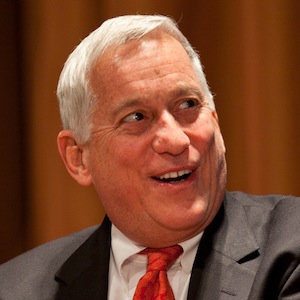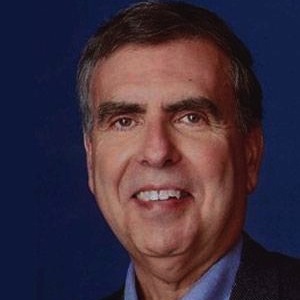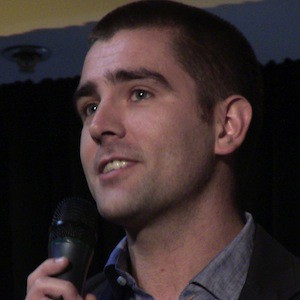John: OK, it’s April 4th, 2013. We’re in the Washington, D.C. offices of the Aspen Institute, John Huey and Paul Sagan, having a conversation with Walter Isaacson, historian, biographer, journalist and head of the Aspen Institute, and digital pioneer. Walter, we have a lot to talk with you about. But in the spirit of this project, can you re conjure for us your first time? When the light bulb went off over your head and you said, “Ah, this digital technology in journalism is going to really change the way this all works.”
Walter Isaacson: Yeah. It was on a New Year’s Eve, after we’d come back from a party, and Phil Elmer DeWitt had been pitching a story called “Cyberspace,” what’s happening online, digital media. I was back of the book editor at “Time,” and late that night, I went online to the Well, which is one of the early bulletin board systems that Phil had told me to go on.
John: This would have been dial up?
Walter: Yeah, totally dial up. It was complicated, because we didn’t even have dial up modems. I had to borrow a dial up modem, it was like 2,400 baud or whatever.
John: Do you have any idea what year we’re talking about?
Walter: I don’t, but we can, for the sake of this, find out when the cover was. Because the cover was, that January, welcome to cyberspace, and we’ll go online in a minute and find out when time ran it. But this was in the very early ’90s, probably ’91, ’92. I’d noticed hundreds of people in these bulletin boards and sort of chat rooms. They weren’t live chat, but it was close, talking about New Year’s Eve and talking about the year, and thinking whoa, there’s this whole cyber community. We ended up doing, three or four weeks later, using the people from “Mondo 2000,” which was an early pre “Wired magazine” magazine about the digital age.
The art directors of “Mondo 2000” doing the art director part, and we even had hypertext, which was…the web had not fully flowered. There were no mosaic browsers yet. But hypertext was still being used. And so we ran the story and some words were underlined or in red, and they would point to things in the margin that would explain it.
Walter Isaacson: Welcome back, fans. John and Paul and I have figured out it was February 1993, it was called Cyberpunks. That was the introduction I got to cyberspace.
After that we said, why don’t we put our own magazines online, and I asked Phil. We started playing off AOL, CompuServe, and Prodigy, because, as I said, this is before Mosaic had made the web very accessible.
At that magazine conference of 1993, in the Waldorf, wherever national magazine conferences are, I remember being with Louis Rossetto, who had just launched “WIRED” magazine.
We said, “Why don’t we put our magazines online?” We had done so with AOL. We were getting, I think, close to a million dollars by bidding AOL, CompuServe, and Prodigy off. But then Louis and I talked a year or so later and we said, “Why don’t we put it directly on the Internet,” as opposed to one of these online services that were walled gardens.
If you put it up with AOL or CompuServe, it had to be their subscribers. They would get revenue by the fact that the longer somebody stayed online with AOL or CompuServe the more they would pay those companies, and we would get a cut of those revenues with approximately a million dollar guarantee.
Then, we decided why don’t we cut out the middlemen, the AOLs, the Prodigies, the CompuServes and go directly online? The thing that we had to figure out, and this was…
Paul Sagan: Who would we have been at the time?
Walter: It was, somehow I was doing it at “TIME Magazine” with Dick Duncan, who was a deputy managing editor, and a few people were talking about it.
Every now and then we’d go up to Reg Brack, who was then the president of TIME, Inc. He would say, “Well who owns the Internet?” and things like that.
But we had made these deals with AOL, Prodigy and CompuServe without much corporate knowledge or interference until it got to be about a million dollars of revenue a year, at which point they were paying attention.
Then, we had to pitch to them, we can cut out these online services which wasn’t a good idea, because the online services were giving us money, but it was an inevitable idea.
We realized the online services were probably toast when people could get to the Internet directly as opposed to doing it by using a dialup, going to AOL. Then, you go into AOL’s walled garden, and then you can go out to the Internet at large almost as if it were through a gate in the garden.
I remember having a conversation, again with Louis Rossetto of “WIRED,” and it was, how do we go online directly? Believe it or not back then there was no clear way to be on the Internet.
There was something called FTP, which is a file transfer protocol. There was Veronica and Gopher and Archie, which had all been developed by the University of Illinois or University of Michigan.
Paul: And they were just file transfer protocols.
Walter: Yeah, they were file transfer protocols. Send fetch…
Paul: They didn’t go to a page.
Walter: Yes, right, but could actually get a page or get content by having a Gopher or a send fetch, get that page, bring it down to your computer, and then you could call it up. A very static sort of thing.
Paul: What was it that excited you about this? What was the promise? Why, other than the fact that it was new and really challenging and exotic, was it a journalism creation excitement or a business opportunity or both? What was it?
Walter: I think what excited me from the very first time in late ’92, New Year’s Eve of ’92, when I saw the community, is that journalism had been things that you handed down, sort of engraved on a page.
You maybe got a feedback from a letter to the editor every now and then. But what this was was about community. I think we lost that community when we finally went on the Worldwide Web, which is the way when I was talking about protocols and send fetches, we all just had to be on the web, which was basically a publishing medium.
But before that the Internet had been very much community based, like the Well or these chat rooms.
The notion that you could put information into that context and, then, have a conversational community grow up around it seemed to me that that was going to take journalism to whole different place.
That journalism was not just going to be the elite guardians of journalism handing down on pages the reporting of our time, but people putting journalism into a mix that would then create communities of discussion. That’s not the way it evolved.
Once, we went on the Worldwide Web the web, as beautiful as it was, was much more of a static medium and it didn’t have the conversations and the chat rooms and the bulletin boards wrapped around it.
Paul: A lot of it, for a long time, was just recreated print product with a few extras.
Walter: Right. It was pouring old wine into a new bottle as Arthur Hochstein, our art director, said, and it was disappointing in a way. Because, as excited as we were to go on the web, something was missing and I couldn’t put my finger on it.
But I realized after a while that it was, even on AOL, which was not nearly as cool and it was not really as vibrant as the Worldwide Web, if you were on AOL, most of what we did was help moderate the bulletin boards around each story. Where hundreds, maybe thousands of people would be talking about the story. You’d bring in people for interviews and you would…
Now, there’s some of that that happens now on the web, but I suspect there’s less community and conversation per eyeball on the web now than there was back in the early ’90s when bulletin boards and chat rooms of CompuServe, Prodigy and AOL were at the center of what online was and the handing down of the journalism was sort of peripheral to it.
Paul: It seems now that the conversation has become highly fragmented. I mean, Twitter is the conversation now. It’s kind of hard to… I don’t know how to compare the two.
Walter: With no barriers to entry, you have a thousand bloggers and hundreds of aggregations of bloggers and then, millions of tweets per day that you could go through.
It reminds me, if you want to compare it to a time, of eighty years ago when Henry Luce is saying we’re bombarded with all of this shit. Why don’t we have somebody help sort it out and package it for you?
Maybe the pendulum will swing and we’ll get back to the place where Flipboard is with Josh Quittner supposed to help you collate tweets and blogs and content that might interest you or whatever. But there’s nothing…
Arianna Huffington is getting close to it with the HuffPo.
Paul: This thing takes off pretty soon after this point, and it turns into quite an adventure. Big corporations get involved, including the one you’re working for at the time, and it leads to a larger online effort, right?
Walter: Right, I think it’s at the beginning of 1994, and there are memos that…
Paul: This would’ve been pretty fast. New Year’s Eve, you’re only…
Walter: Yeah. Basically it was early ’93 when we did Cyberpunks. Then, at that point in early ’94, and Paul maybe should come over to this side of the camera, but I think…
Paul: Maybe.
Walter: Yeah, in fact, seriously. OK…
Paul: I will.
Walter: But I think in early ’94 we were still pretty much online with the AOLs, CompuServes and Prodigies…
Paul: And bidding them off each other.
Walter: Bidding them off against each other. But at a certain point Mosaic comes out of the University of Illinois. Marc Andreessen does it.
Paul: I remember the meeting we saw it.
Walter: It was what year, approximately?
Paul: Probably ’94.
Walter: Right.
John: I think you put it on the cover in ’95.
Walter: Barefoot on the cover…
Paul: In ’95, but it came out in ’94.
Walter: In early 1994, a couple of things happened. One was we got pitched by Marc Andreessen, who had created a browser that allowed you to go on the web.
Paul: It was before that. Even before Netscape. We got a demo of Mosaic out of Illinois from some editor at Entertainment Weekly who had it on a computer. But I remember we had to cross the street and go to their building, and he showed us websites. They weren’t [inaudible 0:01:40] and it had the little snake y looking thing.
Walter: That was I think around the time I was talking to Louis Rossetto which is, there’s FTP, there’s Gopher, there’s syntax, there’s Archie, Veronica, there’s this thing called the web and we had seen it. It was like, is that what we should for our magazines?
Paul: Because you could have direct access to the customer. No more proprietary services, but you could have your own look and feel.
Walter: Have your own look and feel. What we lost in making that transition, as I said a moment ago, is the notion that it would all be embedded in community. Because, although you could put comments up on websites, it was no longer a community service, it was a publishing medium. You and I, at that time — this is early ’94 — had also been tapped by Jerry Levin, to create a service for the television that was called the Full Service Network. That was an interactive television system that Time Warner Cable was going to roll out starting in places like Orlando, but we tested it in Elmira, New York. I think.
Paul: No, we tested that in Maitland, Florida.
Walter: Maitland, Florida.
Paul: That was the first and only market of the Full Service Network, which was fully interactive TV. What today we would call VCR functionality. Built on SGI gear, and when SGI close, that team went and started Tivo.
Walter: Right.
John: Went and started what? Tivo?
Paul: Tivo. They invented Tivo.
Walter: In other words, it was a cross between an on demand cable network and a Tivo service. You could watch any show you wanted when you wanted, on demand. It had some drawbacks, one of which was the SGI set top box. You could fry an egg on it, if I remember. It used to get really hot.
Paul: It was a workstation.
John: The word is out Walter that you still have one of those full service…
Walter: An SGI Full Service Network, gosh, I don’t know. I’ve got to work in the archives.
John: If you do, take a photograph of it and sent it to me.
Walter: I will send it. You should start an archive at Harvard. I’ll send all my stuff there. We were doing that.
John: That was separate from the Internet?
Walter: That was totally separate from the Internet, in fact, we were the ones who tried to get their minds around the fact that this and the Internet were going to, whatever it’s called.
John: Jerry Levin told us that he distinctly remembers the first time he ever really heard of the World Wide Web, you showed up in his office and said, “There’s this thing called the World Wide Web, and you need it.”
Walter: Right. That’s because Paul and I were working on what was called News on Demand, which was going to be one of the many services on this television on demand thing that they were creating in Orlando.
John: Just for the record, Paul, how had you come into this orbit?
Paul: I was in the cable division, starting regional news channels, working in New York, starting New York One and then a series of other regional news channels. This was pre the company even owning Turner. There was no CNN and Time Warner at the time. Levin asked us to work together, to do interactive TV. The more important distraction was doing online.
Walter: Right. Interactive TV was tested out in Orlando. We created a news on demand service. I can’t remember what we branded it.
Paul: The News Exchange.
Walter: The News Exchange. Very good, Paul.
Paul: TNX.
Walter: Yeah, you probably have a t shirt.
Paul: Probably have a t shirt that should go in the archive too.
Walter: The News Exchange, that caused us to have lots of meetings with people at CBS, ABC and NBC, because we didn’t own CNN. Time Warner did not own CNN at the time. To say to Howard Stringer, “Why don’t you give us your news shows? We can chop them up, have it on demand.” Paul, who had created New York One and knew how to create news too, you could say, “I want this story,” or, “I want only sports,” or, “I want to tailor my newscast.” All the things that you can now do on the web, this was supposed to be done on your TV set, through a big remote control that was not a very good interface. We hired Iconic to try to do a simple interface, but it was not Steve Jobs like with an iPad or an iPhone.
There was a complicated interface. It never really took off. But while we were doing it, we were getting these demonstrations, Mosaic, we were being told what the world wide web was. I had been, before Paul, putting Time Magazine on CompuServe and things like that. It occurred to us, Paul and myself, that what we were doing for television on demand, was someday going to merge with or be the same as the interactivity you would get online, or on the Internet.
So, at some point, at the beginning of 1994, I think it was, we did make a pitch to Jerry Levin. I remember writing a memo to Jerry Levin, which is in the archives here, that said, “Hey, this on demand television stuff is great. But let us use a very small percentage of the money you’re throwing at it and create a prototype of how you could do it on computers online.
He said yes. Because we showed him how online would work.
John: He refers to it, in his interview with us, as, “Yes, there was Pathfinder. That was a step child,” because he was so obsessed with the full service.
Walter: We created The News Exchange and then a broader thing around it, which was called Roadrunner.
John: What was The News Exchange?
Walter: The News Exchange was simply a chopped up video news that you could pick which stories you wanted to watch, in the order you wanted to watch them.
Paul: Or you could put in a profile.
Walter: Yeah. You could say, “I’m interested in sports, crime and news about Poland,” and theoretically you would get the news about it.
John: Where were you getting this content?
Paul: We were licensing, as a test bit. We didn’t pay for it, but from the big networks. CNN, CBS.
Walter: This is when we were meeting with Howard Stringer, NBC.
Paul: They all let us use it, because it was a walled garden. There were 5000…
Walter: Then we tried to make a big deal with one of them, at which point it got so wrapped up into ABC versus Time Warner politics. Even when you turn on your cable system, will you go to the last station? We said, “We can’t deal with that.” So we never were able to make the big deal with any of the TV networks to use all of their content, repurpose it and do news on demand.
Paul: But it was enough to see that people wanted choice.
Walter: Oh yeah. We did a test of it and it was cool.
Paul: You could get your or my television newscast, effectively. The other thing the system could do, you could play multi player games against your neighbors. They were Sega games. You could buy about three things.
Walter: You got movies.
Paul: And you could watch movies. You could watch them with what, today, would be on demand.
Walter: Tivo.
Paul: It would start and stop. Tivo. And fast forward. But only whatever was on the server at that end.
Walter: That was being delivered, by coaxial and fiber optic cable to the home, into a big server that was basically a Sun workstation called an FPI server, right?
Paul: Server at the head end, workstation in your home.
John: Great vision. Great Product. Ahead of the curve of the technology.
Walter: We should have it now. This advance will happen 20 years later than we tried, which at some point you will be able to go to your TV set…This is what Steve Jobs was trying to do a couple years ago, before he died. Which is create a TV set that had access to whatever you wanted to watch whenever you wanted to watch it.
John: This is going on, in parallel to that you’re starting to think about the magazine?
Walter: As this is happening, we’re saying, A, we could do this on the Internet. Maybe even we could deliver the Internet via cable, which would give you higher bandwidth. So, Paul and I created two concepts that we pitched. One was an Internet online service that would have a lot of the magazines and things. The second, which we named Roadrunner and which is still named Roadrunner, was a cable connection to the home computer.
That would allow you to get broadband in the home, and which we hoped we would have the front end to it. This is not something that ended up happening. But if Time Warner gave you access to the Internet through cable, we would package it almost the way AOL created a shell for when you dialed up to the Internet.
Paul: And own the home page.
Walter: We’d own the home page. That’s what I meant. Just like when you dial up, AOL then has your eyeballs for a while, we would have your eyeballs. So, we created two things. One was a regular narrow band service for the magazines, which we ended up calling Pathfinder. The other was a high speed one that was called Roadrunner.
This was in early 1994. We pitched to Jerry Livine and others, especially this notion of having a cable powered online service that would have all the content from all of our magazines, and would help be the next generation online service. It worked pretty well. We created something called Pathfinder in 94. It was like some of the aggregators, like The Huffington Post, in a way.
But it was Time Magazine, Sports Illustrated, and People. It was all on a home page. The problem was multiple. One, we didn’t have enough revenue to make it into a huge online service. The second is, once people got on the web, they didn’t need people to package things for them. They’d go to wherever they wanted.
Paul: That’s right. It was arguably the first portal. We looked at the ones that developed around search, which were really guides. We were wrong. We kept saying, “We could build a guide too.” We looked at Yahoo and said, “We could do that too.”
Walter: There were two things that were like that. One was just search, which is what Google now is.
Paul: Which was the next step.
Walter: The other is what we called directory guide.
Paul: We literally had people in the back room indexing websites.
Walter: It came from a list called, I think, Judson List. Well before Yahoo or anything else.
John: Yahoo was a list, originally.
Walter: Right. But even before Yahoo was a dream, there was some kid somewhere who was blogging a little bit, but started doing, “My favorite websites.” It would be sports. It would be art museums or whatever. We said, “That’s how it’s going to work. It’s going to be a directory service. That’s how you’ll find things on the web. You’ll go to a directory and find it.” We did not think that kids at Stanford like Larry Page and Sergey Brin or Yahoo or whatever would create an ability to search the web well. Then we thought, “We can just license these search engines.” We would be in control because we had the content. There was a phrase back then, that content is king. We actually believed it. In fact, at least for 10 years of the Internet, having the best algorithms and everything…
Paul: Content is king. It’s just we thought we would have enough of it.
John: If you look at what the VCs have backed and what the big scores were, the really big scores have been more platform than content. They distribute content. But Google is a platform.
Walter: They distribute content that they don’t make.
John: Right. As someone has pointed out, Google is not trying to get you to come to them and stay there. They just want to help you on the way to anywhere you want to go. Facebook is also a platform. If you look at the content plays, some of them have made some money. But they haven’t gotten any traction or changed the world. Nevertheless, Pathfinder… I’d like you to get to speak in defense of Pathfinder a little bit here. Because Pathfinder was much maligned unfairly, in my opinion, and became the butt of some jokes. In fact, it pioneered a lot of things. I think, it was one of the first, if not the first, to run a banner ad.
Paul: Probably one day before was Wired’s site. But it sold banner ads first.
John: Talk a little bit about some of the legacies…
Walter: Let’s go to the banner ads for a second. That was important. Pathfinder was good for what it was, which was a portal. It was a place you landed on if you went right to it. It would help guide you around the net, but it would also have a lot of content. Bruce Judson was on the business side, working with Paul and myself. He came up with the concept of a banner ad. We had always believed that what we were going to do was bring people into this portal. Then, when they got the content, they subscribed to it. They would pay for it, just as you paid for any other service or magazine or subscription you had. We had an elaborate scheme for charging people. Almost like The New York Times is doing now.
You got a little bit for free. But then at a certain point, a pay wall hit. I remember, vividly, the day mid 1994 or so, when Bruce Judson had come up with these ads you could put on top. Yeah, Wired did it as well. But it was like the microchip being invented in two places at once.
Paul: It was literally one day apart.
Walter: It wasn’t the hardest concept in the world, which is, “Let’s put a banner ad on top of the…”
John: Sony and Phillips developed the tape recorder at the same time.
Walter: Right. That was a more complicated invention than the banner ad.
John: It wasn’t a complicated invention, but it drove a lot of the whole shape of the business for a long time.
Walter: It really transformed everything. Immediately, Madison Avenue decided, “Oh my God, we’ve got to understand this. We have to hire a lot of young people.” They would send us money. It was almost like you could look out of the Time Life Building to Madison Avenue, and watch people walking with bags of money, to dump it on our desk, or Bruce Judson’s desk, to buy banner ads, because they all wanted to be in on this thing. What this does is, it taught us we shouldn’t charge for content. We should just get as many eyeballs as possible. That’s the way we’re going to make money — by aggregating eyeballs.
John: The great traffic chase.
Paul: Something else went on, which was, we were still getting checks from the proprietary services. There was other revenue that came in. We gave them more content, but we gave it to them with [indecipherable 0:17:25 — Alex guess: “the chats”] . We also created a personalized version of Pathfinder, which was going to be your customized news piece, which was going to be, effectively, your sets of the stories. A bit of the lesson we learned from the full service network, which was people wanted to personalize.
That was going to be a subscription service. We cut a long forgotten $5 million deal with CompuServe. CompuServe was then chasing AOL to catch up on the web. They were going to offer this free if you stayed a CompuServe subscriber.
Because of that, we then didn’t promote it very hard anywhere else. That turned out to be a great short term bet, because the check didn’t bounce. It turned out to be a long term bad deal, because they cratered and went out of business.
Walter: Right. At that point, for most of our content, we had bought onto the notion that it will be for free on the web, with banner ads. So we weren’t trying to protect these online services. They were trying to get our content exclusively. We began to buy into the notion that content wants to be free.
John: Somewhere along that same time is when Reuters decided to sell news to Yahoo, to give away for free. That’s when Yahoo quickly became the biggest news provider. That changed the whole landscape. Everyone accept DOW Jones — and we have a long segment on why that happened differently — chased the great God of banner advertising. Life was beautiful for a short time.
Walter: That was unsustainable for the long term business model. Because the number of Internet pages, servers and sites would grow exponentially, but the number of ad dollars did not grow exponentially. In fact, it shrank for a while, after the American auto companies had trouble.
Paul: They moved to search.
Walter: They moved to search. They moved to Google and Yahoo. The CPMs you’d get for a banner ad started plummeting. At first, it was the coolest thing in the world you could do. Then you could do it anywhere and you didn’t need us.
John: I want to ask a question that I think both of you are particularly qualified to speak to. Three themes have come up in all these interviews, about why legacy media had such a hard time getting through this and, indeed, ended up losing control of the narrative of this whole progress of technology. One of those themes is that legacy publishing companies never valued or understood the power of engineering. Somebody, I think Sheryl Sandberg, said one engineer is worth 10 mediocre engineers. The publishing companies, none of them really developed any semblance of an engineering culture. The other is, of course, the innovator’s dilemma. We all know what that is. Basically, you’ve got to protect your core business, where the profit is. The third one speaks to the whole thing you were just talking about there, with the $5 million deal.
They didn’t really see a threat. They saw an opportunity. When they saw a chance to monetize quickly, they just took that. They were in the business of banking quarterly earnings. If you could just talk about what happened, going forward with Pathfinder, with all three of those things in light — getting corporate momentum, cultural issues, engineering, all of that.
Paul: I think we did a good job for about a week, on the engineering side. We found a few people like that editor at ADW, who showed us the browser. We got convinced that a cable into the wall, to the phone company and a Mac and you were in business and you could compete. I don’t think we had any appreciation — it was the same issue of not fully appreciating what was behind search, for example — of the difference between what went on in Silicon Valley and what we were doing with the publishing world, with a few people who understood the technology a little bit.
Walter: I would totally agree with that. The number one thing you said, the engineering, lacking appreciation, was the biggest problem. First of all, you’re in New York City, unlike in Silicon Valley. So, there are not a zillion engineers hanging out with you. And you think you can just buy engineering or rent it, or lease. We thought, “We will just lease Google or Yahoo or Magellan.” You have to remember, by the way, that a lot of these engineering plays ended up totally bankrupt. I could probably list Lycos, Magellan, all these things that seemed like…
Paul: Hundreds of companies that went under.
Walter: Yeah, that just totally went under that had created search engines, a directory, whatever. But we thought, “There will be all sorts of companies writing algorithms for search.” We didn’t know Google would get it right so strongly.
John: There was a period of competing search engines.
Walter: We thought, “There will be many search engines and many engineers out in Silicon Valley writing them. We’ll play them off against each other and say, ‘If you don’t license to us and give us half the revenue that comes from the search, then we’ll do the licensing deal with Yahoo or Magellan or Lycos.'” Whatever it may be.
John: Did either of you ever advocate for buying one of these, a Yahoo? I’ve heard people say…In fact, I think Mike Moritz said something about this.
Walter: Yeah. I remember talking to Mike about it. I can’t remember all the details. But we tried to make some deals. As I assume Ted Leonsis told you, we were thinking of buying a fledgling AOL, a decade or two before they bought Time Warner.
Paul: Just one other point on the engineering. Not just that we didn’t understand the differentiation of needing engineers or that you probably need to be California. Maybe arguably then you could have at least done it in Boston. But we played in Manhattan, which was not the right place. This is a little the innovator’s dilemma. It was the culture of, “Good enough is where you should start,” versus “It has to be perfect.” Engineers throw stuff against the wall and learn from the failures. Most of the web companies have had lots of things that didn’t work or they just call them beta and throw them out there. We lived in this world that was quite afraid of failure and bad publicity. One of the first things we did at some scale, we tried to charge for an event or something.
It crashed. It wound up being a story in The New York Times and The Wall Street Journal. It was written about Time, Inc. and it was an embarrassment. So the next time we did one, we were told, “Just don’t let it crash.” That was a standard we probably couldn’t meet.
John: There’s a third issue that comes up. There’s the engineering. There’s the innovator’s dilemma. Then the third issue that comes up, with virtually any strong legacy media company — whether it’s The Washington Post, The New York Times, Time Inc., any of them — there really was and still is, to some degree, an editorial driven culture, where editorial values and editorial power exerts an influence over the process that can be for the good, but if you’re trying to innovate and start a new technology, can be problematic.
I remember a lot of friction back then. I don’t know if either of you do, in terms of magazine editors saying, “That’s not up to our standards. That’s not brand appropriate.”
Walter: I had to change hats a couple times. I was at Time and then went to our new media group, and then I went back to Time. When I was at Time, we used to say, “We can’t let these people use The Time brand unless we approve it.” We have to have Dick Duncan sitting there with committees, approving everything that will have The Time Magazine name on it. That was no way to run a fast moving business. The second issue that came like that was whether the old brands were the brands we wanted. Paul and I invented some new brands, like the Virtual Garden and I can’t remember what they were.
Paul: That’s right. That was a home site.
Walter: Even OJ Central or something.
Paul: We had an OJ site during the trial.
Walter: It was the question of whether a new brand like Pathfinder or an old brand like Time Daily or Time.com…
Paul: Or Fortune.
Walter: …or Fortune would be the best brand to use. That came into conjunction with the greatest organizational problem that’s existed since the beginning of time, since they created this country and had to have states versus national — how much power do you give to each of the entities, versus how much do you centralized power. Places like Sports Illustrated were saying, “We don’t want this central group controlling sports.” We were saying, “Yeah, but if you just do it, you’re just going to be pouring Sports Illustrated into this digital form. We want to create a new type of sports site.”
Paul: One that was real time.
Walter: Real time, had games and everything else.
Paul: I will give you one more anecdote and then we’re going to return to a one on one interview with Walter. Talk about the future. But when you went back to Time and then I was in charge, shortly thereafter, we did a story under the People brand. It was a people.com only item, covering the opening of what was going to be the new hot franchise restaurant business. It was going to be super models. They opened one in Rockefeller Center. We sent our own photographer down. We did a snarky web sensibility photo essay for people.com. I got called by a junior publisher, screaming at me, from People magazine. How could we do this? How could we do something that’s out of character for the magazine?
Our advertisers will be furious that their brand was associated with our brand and this snarky story about these super models opening a restaurant. I thought, “If we can’t figure out how to do this story, that was not hard news, and do it in a way that I thought was in keeping with People’s brand, but with a little web sensibility, we’re never going to get out of the [indecipherable 0:27:59 — Alex guess: “mud”].”
Walter: That leads to the great lesson, the great thing, that I think the failure was. At Pathfinder, we should have not based it and given the power to each of the brands — People, Fortune, Time. We thought, “Things like People, Fortune, Time are huge.” We should have said, “We’re going to create a whole new service. We’re not going to base it on each of the magazines. We will create our own sports, our own news, our own snarky celebrity coverage.” Then, once it’s successful enough, we probably should have taken some of the brand things in. But instead we let the brands have veto power over what we could do.
John: Yeah, stay there for just a minute. One of the things Jonah Peretti said in his interview, he talks about the high low. He works from a point of view that you can write about a lofty subject in a low way or a low subject in a lofty way. In some ways, Henry Luce pioneered that model. He used Time and Fortune for great prestige and made a lot of money with Life, not to subsidize it but certainly make him a lot larger, financially, than he would have been.
When you look back at Pathfinder and you say, “If it had subsumed all the brands, it had all the subjects.” But wasn’t one of the problems that it was also built around the newspaper model, in the sense that it had a sports vertical, a business vertical. In the end, as Walter said earlier, the consumer broke out of all that. They weren’t looking to one provider to give them all that.
They were just looking for the information they wanted. It would have had to evolve greatly anyway.
Walter: It would have, but I don’t think anybody’s ever yet licked the model of how do you create a great site that aggregates and helps you guide to the content you really want each day. The best you do is search on Google News or something or Yahoo News, but that’s still hit and miss.
John: If it makes either of you feel any better, I’ll tell you that for years and years after both of you have long gone and this thing was long forgotten…I’ve sat through many a meeting where people would pitch an idea and many times I was supportive of it. I would say, “But I’ve got to tell you. You’re talking about Pathfinder 2.0. This is not a new idea. I support it. It’s a good idea, but it’s Pathfinder 2.0. This is not a new idea. It can be done a different way.” I, for one, still think the legacy of Pathfinder is more significant than it gets credit until the definitive history has, of course, hit the pages.
Paul: Whoever writes the history gets to decide who gets the credit. It’s good that we’re writing it.
John: You’re writing it, that’s right. One last question for the two of you is, and this doesn’t speak to just Pathfinder but it speaks to the whole force of digital journalism. Walter, if one of the premises that we’re working by is we have this metaphor that if you think of a line, a horizontal line. Below the horizontal line is the tide. The tide blows and gets stronger and stronger and it comes in.
Above it are swimmers. Some of the swimmers are going with the tide and some of them are going against the tide. Many of them don’t make it and some of them make it to the shore.
When you look at the whole landscape of legacy media through this process, was there really anything that anybody could have done any differently that would have ultimately made a profound difference in the course of things? You can certainly make arguments that company A could have done this and survived longer. You can look at Knight Ridder and say Knight Ridder didn’t have to die as early as it did when in fact it was a company with as much digital vision as any, more than most.
Walter: More so.
John: Tribune had a lot of digital vision…
Walter: [indecipherable 0:32:20]
John: I tell you, we have not interviewed yet…We’ve interviewed almost 50 people. We have not yet interviewed a stupid person or a person who didn’t have a vision that makes a lot of sense and who didn’t know what they were doing. One of our big questions is, ultimately, does the tide just rule the day, or…?
Walter: Sometimes technological disruption disrupts, which is why it’s called that. Meaning, you can’t fight the tide of a new technology disrupting things. The major disruptive impact of digital technology was that it allowed people to go anywhere they wanted and for that matter to replicate content infinitely with no marginal cost. Meaning, there was no marginal cost, so content became free. To me, that was the one thing that maybe the technology forced it to happen, but if we had prevented it, life would be a lot different from most media companies, which is find some way to meter the use of content so that the people who produce the content, just like the people who produce songs that are played on the radio, get paid some royalty or some copyright compensation for having sent somebody to Baghdad and having produced a story. I don’t know how we could have prevented all of that stuff being out there for free as it is now.
You’re starting to see the genie being smooshed in the bottle a little bit. “New York Times,” “Wall Street Journal,” others putting up paywalls and apps on the iPad and Android tablets being things people have to pay for.
The great disruption that happened is when those who produced the content no longer got paid for producing content. That undermined the media business and I still look for ways we could have maybe made that happen differently.
John: Paul, that was really the big question that above all that hung around your neck when you came into this project. You’ve now interviewed like 40 something people. Just a preliminary, having heard what Walter said, would you agree with that? Or where…
Paul: I would. I think the dilemma is exactly as Walter said. I don’t think — because we’ve asked everyone this idea of the original sin. Had we just been patient and not gone for free, would the world be different? I think the tide was too strong. One, I think the business pressure was way too large to have been left out. But had we been able to have a secret conference and everyone conspired to agree, I think the example of Reuters and Yahoo wouldn’t have shown up at that conference and they would have set headlines for free, and search was going to still get people to sites and blogs.
I don’t think you could have held technology back for 20 years until today and now say we have paywalls and everybody has to stand on the outside and pay to get in.
Walter: Right. I now look at a point in which I say, gee, if we set…because I know. I mean I felt the pressure. If we did not put “TIME Magazine” out there for free, Newsweek, which was hungry and scrappy, it put itself out for free and for a long time would have gotten banner ads that would have made it worth their while, even though we could see that’s not a sustainable model, which is why Newsweek’s no longer around as a print product. But I don’t know how we could have stemmed that tide, but that is the one big, if not original sin, at least turning point that we couldn’t stop when the tide turned on that.
The other way to have done it. Early on, the Worldwide Web, when it was conceived by Tim Berners Lee, there was what we called requests for comments where they got to put things into the web. One of the things that Tim Berners Lee wanted was a system within the web that tracked where each piece of content came from and was able to allocate back to that piece of content a royalty for that content. That was going to be built into the protocols of the web, and thus maybe Internet service providers, anybody who created it would have had to negotiate just as the way radio stations used to have to negotiate with record companies…
John: ASCAP and…
Walter: Yeah, and ASCAP. That was a turning point that could have happened, but that was a technological miss when the people inventing the web did not go along with, “let’s find a way to meter the content.”
Paul: You would’ve created a concept called content peering, which would have been…because it wasn’t just done for royalties. It would have been done for balancing traffic. Right?
Walter: Right.
Paul: And you would have known where it came from, and it didn’t get done.
Walter: Right. [crosstalk]
Paul: Because there was no way to hold people accountable in that…
John: Another thing that happened that I think is not insignificant is, we’re talking about all this now looking back and it all seems cool, calm, and collected and we’re talking about it in a rational way. But the fact is several companies came along that started making billions and billions and billions of dollars off of this, and it was quite a heated frenzy, and it was much like a war. And in the fog of war…
Walter: But wait, who was making billions and billions, besides Google?
John: AOL made a lot of money. Yahoo made a lot of money. Google made a lot of money. All these platforms. eBay made a lot of money, Amazon, now. They’re in different…You’re getting further…
Walter: But what they all have in common is all five of them, none of them produced any of the content that they made money off of.
John: No. No, they didn’t make the content. Nope, no content.
Walter: Neither Amazon, nor Yahoo, nor eBay.
John: No. That was my point earlier. That in the end…I mean you can look at a few content companies that made some money selling for this and that to [indecipherable 0:38:24 — Alex guess: “superstacks”] or whatever, but in the end, it was the platforms that made the real money. My only point is, that money really served as a powerful force to make things happen. I don’t want to get deeply into this at all, but that’s how AOL ends up buying Time Warner.
Walter: You and I were there in China when Jerry Levin and Ted Turner and Steve Case were all there, and I was watching Jerry Yang, thinking they were going to make a deal with Yahoo.
Walter Isaacson: It’s been 20 years since we created Pathfinder, and every now and then I say, “If I had known then, what I know now, 20 years later, after Amazon, Google, everything else, wouldn’t it have been great? We could have invented whatever the big thing was.” I still, with 20 years’ hindsight, am not sure how we could have done it that much more differently, other than having great kid engineers at Stanford inventing the algorithm of Google, that would have worked. There are no decisions I can point to that we made, even with 20 years’ hindsight, that would have made Pathfinder into Google.”
Paul: As a matter of fact, I think I can envision the meeting where somebody says, “Search is really great. We can’t make any money, so we need to charge for likes,” and we would have had an editorial reaction which is, “Well, wait a minute. We’re going to be bastardizing basically what we think is a pure response, and we never would have done it.”
John: By the way, it wasn’t the invention of the algorithm that made all the money. It was the decision to make search driven advertising is what made all the money and what ultimately created all the disruption in the industry. When people ask me what’s the biggest mistake you think Time, Inc. made, I say, “Very simple. We failed to invent search driven advertising.”
Walter: Right.
John: And I don’t think we were likely to do that because it was a disruptive threat to the entire revenue base of the company, and very few companies…
Walter: I would have been happy if Paul and I could have invented that because I didn’t care about being disruptive. The problem…
John: The truth is, if you’d just been able to get the engineering and the tools and move forward, if you’d just have invented Yahoo you would have been fine.
Walter: That’s what I was going to say. If we had not been sitting there in New York, where we thought, “Inventing algorithms to do spiders and searches of the web, that will be the great key that unlocks the billions.” That was the only thing that we could have done differently. Saying, “Creating all these gardening, and recipes, and cooking, and OJ, and world news stuff, that’s useless. Let’s find 20 of the world’s greatest coders and engineers in a dorm room at Stanford, MIT or Harvard. Let’s create the best search algorithm.” But do remember that there were 10 or 12 other people who were creating these great search algorithms, and they all went bankrupt. Somehow, Google won the race. It’s partly because they figured out advertising based on search. It’s partly because their search engine crushed all of the others.
Paul: And they got distribution.
Walter: And they got distribution. Would we in the Time Life building have been able to invent a better search engine than these kids at Google? Probably not. But if I could have picked one thing to have done, it would have been, instead of hiring all these kids doing Pathfinder sites, let’s invent a search engine that’s going to be better than the other 10 out there. That would have made billions.
John: But the truth is, in a legacy media business that’s in the journalism business, there was no mechanism to bring together editorial, advertising and engineering interests in a way that could create…
Walter: We brought together the advertising and editorial interests when Bruce Judson invented the banner ads, along with “Wired,” and helped transform what a website was. It probably occurred to Paul a little bit more than me. It never occurred to me, to say, “We need to get the best engineers coming out of MIT and hire them at very large salaries.” Instead, we said, “We need the advertising and edit people.”
Paul: That’s right. That’s where the money way. And the money was still pretty limited. We talked to Roger Fidler at Knight Ridder, who did the tablet. His budget, in his peak year running his lab, was a million bucks.
John: There’s a famous video with them demonstrating a tablet in…
Walter: It looks just like the iPad. Paul sent it to me.
Paul: But you cannot compete there. And even though our budget was a little more than a million, it wasn’t enough to…if you look at the hundreds of millions that have gotten spent on engineering failures, we weren’t likely to play in that game.
Walter: Right, and if you look at all the really brilliant people who invented search engines, 95 percent of them failed. So if we had spent millions of time and money to have been one of those 95 percent inventing a search engine that failed, that wouldn’t have been good either. They were not willing to take VC like risks, which is one in 20 of these will pop. Yeah. All right. With that addendum…















